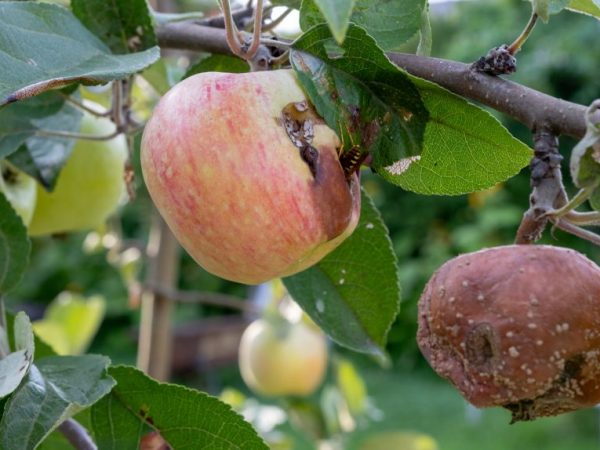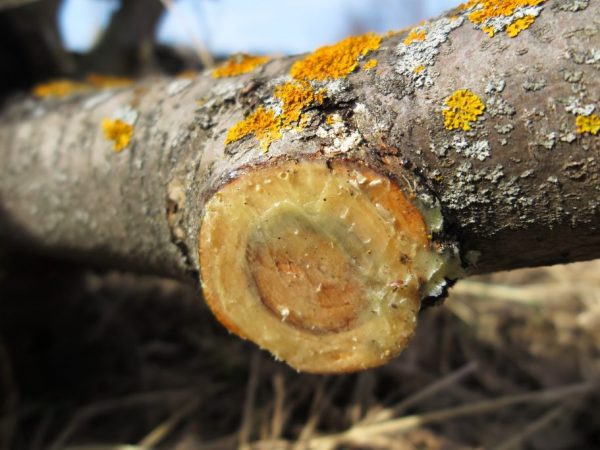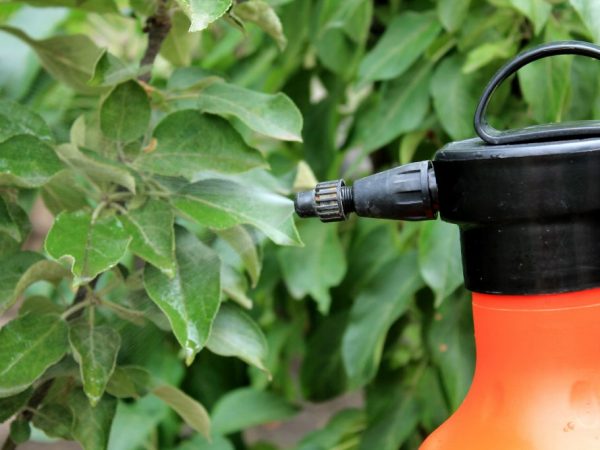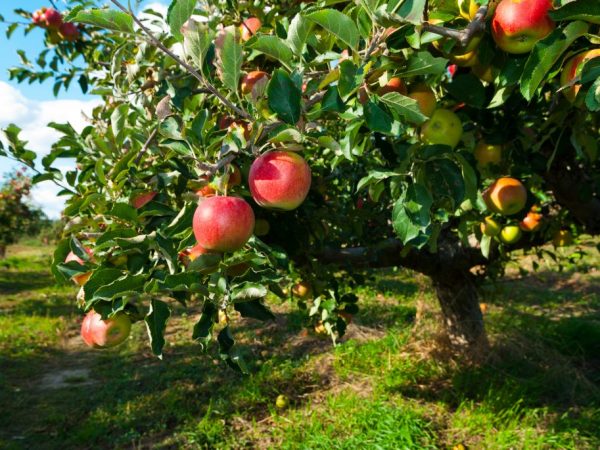Fighting black cancer on apple trees
Black apple crayfish in a short period of time is able to destroy all fruit trees. It is characterized by the intensity of development and distribution. It is quickly transferred to healthy plantings.
- Etiology and types
- Views
- Causes and symptoms
- Symptoms
- Black cancer treatment regimen
- Stripping
- Treatment of wounds
- Protecting healthy trees
- Chemical and biological agents
- Folk remedies
- Disinfection
- Isolation of wounds
- Medicines
- Antiseptics
- Antibiotics
- Injections
- Agrotechnical measures
- When to carry out treatment procedures
- Preventive measures
- Black crayfish resistant varieties
- The difference between frostbites and black crayfish
- Conclusion

Fighting black cancer on apple trees
Etiology and types
The causative agent of the infectious disease is a botryosphere fungus that parasitizes living tissues and dead woody areas. It affects all aboveground apple vegetative parts.
Infection occurs by the ingress of fungal spores through mechanical damage on the surface of the bark.
Views
According to the description of a fungal infection, it produces in two forms:
- closed - there are no open areas on the infected tree, and the lesions are located under the formed tree influxes and other neoplasms;
- open - non-growing open fragments are formed on the apple tree, surrounded by growths of large diameter along the perimeter.
The open form of leakage is the most common.
Causes and symptoms
More often, infection with an infection occurs in early spring, when the air warms up to positive temperatures.
Fungal spores begin to actively spread at an ambient temperature of 22 ° C and above. The average germination time under favorable conditions is 6 hours.
More often, black cancer appears in an old apple tree. But there are also completely different reasons:
- weakening of the garden culture due to concomitant bacterial, viral or other fungal infections (for example, scab, powdery mildew and others);
- low immunity and weak regenerative function of trees due to their age;
- excessive thickening of the tree crown and poor organized circulation of air flows;
- irregular pruning of old and damaged branches;
- intoxication of the garden culture with fresh organic fertilizers applied too close to the root system by digging;
- preference for an intensive garden with a compacted planting if the recommended distance between trees is not observed;
- planting apple trees near the location of compost pits, in which organic matter is actively decomposing.
Favorable factors for maintaining the normal life of the fungus are mosses and lichens that have settled on apple trunks, which maintain a warm and humid microclimate, and an excess of nutrients in the soil, creating a comfortable environment for the development of fungal conidia.
Symptoms
At the initial stage, it is difficult to visually identify black cancer on an apple tree. External signs of infection are detected by a change in the vegetative parts.
Tree bark
The tree bark is examined for the presence of fungus in early spring, and wounds, cuts, frost holes and cracks are examined with a magnifying glass.
What does the bark affected by the fungus look like:
- small specks that have accumulated in the form of circles around the wounds;
- dark focal lesions with a purple or brown tint on the trunk and skeletal branches, outwardly resembling burns;
- cracking of tree bark, its everting and exposure of wood, which begins to blacken over time.
The last stage of the disease, which leads to the death of the tree, is indicated by the formation of peculiar rings around the branches, trunk and at the fork in the skeleton.
Inflorescences
Cancer fungus on inflorescences leads to a change in their color to brown on the outside and black on the inside. The inflorescence itself is deformed.
Apples

Disease can ruin crops
On ovaries and apples, the infection does not show obvious signs at the initial stage and becomes noticeable when they grow to medium size.
On immature fruits, black cancer appears as small putrefactive specks.
Over time, these points increase in diameter, becoming covered with mushroom spores, covering the entire surface of the apple. The fruit turns black and has a smooth surface.
Foliage
Fungal spores that have settled on apple foliage change its color from green to dark brown or reddish. In the center, the spores form point fragments, gradually grow around the circumference, turning into a single gray spot.
Damage to the foliage by the fungus leads to its wilting and subsequent fall. Often, gardeners, due to infection of the leaves with an infection, observe summer leaf fall.
As a result of damage to foliage in trees, the process of photosynthesis is disrupted, which directly affects productivity indicators.
Weakened apple trees do not prepare well for the coming cold weather. In young seedlings, due to a disturbed metabolic process, the wood does not have time to ripen, which is the reason for their death from frost.
Black cancer treatment regimen
Modern means and techniques, which are used in combination, help to fight the disease and completely cure it.
An important condition is to start the struggle at the initial stages of development.
Stripping
Before processing the lesions with special means, the infected areas are cleaned:
- cut off diseased branches;
- remove diseased foliage;
- cut off the affected fruits;
- extensively infected specimens are uprooted, while trying to remove roots at great depths;
- cut off the entire skeletal branches with infection rings;
- local foci on the bark are cut out to a layer of healthy wood, capturing up to 2 cm of living tissues.
All trimmed parts are burned to prevent fungal spores from spreading to healthy trees.
Treatment of wounds
After cleaning, disinfection and isolation of wounds is carried out, processing sections on skeletal branches and cleaned out lesions on tree bark with agents with an antiseptic spectrum of action.
Antiseptics include:
- copper sulfate in solution - 100 g per 10 liters of water;
- iron vitriol in solution - 200 g per 10 liters of water;
- concentrated solution of potassium permanganate;
- brilliant green solution.

The cleaned wound needs to be treated with garden varnish.
In order to avoid the ingress of air, moisture and microorganisms-pathogens of infections, the wounds treated with an antiseptic are isolated:
- drying oil;
- oil paint;
- garden pitch.
Protecting healthy trees
Given the rapid spread of fungal spores by air, they provide protection for a healthy horticultural culture and the preserved vegetative parts of affected trees:
- trunks and branches are treated with disinfectants;
- tree crowns are sprayed with fungicidal preparations and others, which contain copper;
- the whole garden is treated with antifungal agents.
At the same time, when treating black cancer in the garden, they try not to dig up the trunk circles, because such plowing of the soil is capable of provoking the formation of small mechanical damage to the roots and the penetration of fungal spores preserved in the soil through them.
Instead of near-trunk digging, the soil is loosened to a shallow depth and watered with preparations with fungicides.
Chemical and biological agents
Treatment of black cancer in apple trees involves the use of drugs aimed at destroying fungal spores and increasing the immunity of the tree.
Copper-containing products are suitable for disinfection, have a destructive effect on the development of the pathogen and act as a fertilizer.
The vegetative part is sprayed:
- copper sulfate;
- Bordeaux mixture;
- complex substances: Hom, Kuprostat, Tsikhom, etc.
For spraying the soil and the crown, contact and systemic preparations with fungicides are used, which simultaneously affect the cancer pathogen, fungal and bacterial infections and pests:
- Topaz;
- Fundazol;
- Horus;
- Impact;
- Topsin-M;
- Funaben;
- Strobe and similar.
Fungicides keep trees alive.
Compositions of biological effects, made on the basis of the vital activity of bacteria, are included in putties or in solutions for soaking clay, mullein and garden soil (Gamair, Alirin, Fitoporin).
Folk remedies

Folk remedies can be used to treat cancer
You can also cure an apple tree from black cancer with folk remedies.
Disinfection
As disinfectants folk remedies are effective against fungus:
- saline solution with iodine;
- powder for washing clothes;
- soap solution;
- sorrel grass.
Isolation of wounds
It is permissible to isolate wounds from the ingress of air, water and microorganisms using natural ingredients.
- Clay with mullein. The components are mixed in equal proportions, the mixture is applied in a thick (at least 10 cm) layer. Further, a cut or damage to the tree bark is bandaged and again covered with this mixture. Throughout the fruit and berry season, the treated area is moistened with water or a solution of heteroauxin (2 tablets per 10 liters of water) and covered again with a layer of a mixture of clay and mullein.
- Rosin with wax and nigrol. Putty is made from components taken in equal proportions and applied to damage or cut, covering in 2-3 layers, letting each of them dry out.
- Earth. Garden soil pretreated with a fungicide is applied to damage or cut without surface dressing. After the rain has passed, the procedure for covering with earth is repeated.
- Apple bark. The bark is cut along a contour equal to the contour of the damage or cut. The edges of the patch are aligned and bandaged. Cover with garden varnish on top.
Medicines
Black cancer on apple trees is also treated with medications, which act as additional measures.
Antiseptics
For treatment, antiseptic medications are used, including potassium permanganate.
A solution of potassium permanganate is used for minor infections of the apple tree. The working solution is made at the rate of 2 g of potassium permanganate per 10 water. They treat the trunk and skeletal branches, trying to apply potassium permanganate during processing, carefully impregnating the surface.
An additional means of preventing and treating fungal infection is manganese fertilizer.
After processing the trunk and branches with a solution of potassium permanganate, the apple crown is sprayed.
Antibiotics
Antibiotics can also be used to treat apple cancer. Streptomycin and tetracycline are used more often:
- for the initial treatment, 1 g of streptomycin is diluted in 5 liters of water, the frequency of treatments is 3 with an interval of 2-3 weeks, to be carried out in June;
- re-protection with an antibiotic is planned for the next fruit and berry season with the replacement of the drug with tetracycline, it is bred in the amount of 2 tablets.for 5 liters of water, frequency of treatments - 3 with an interval of 2-3 weeks, to be carried out in June.
At the onset of the rainy period, the garden culture is treated without maintaining the prescribed interval.

Antibiotic treatment will save the tree
Another scheme for the use of antibiotics is acceptable, in which the recommended dose is taken for the initial spraying, and for each subsequent spraying, the concentration is increased, diluting 1 g of the medication, first in 4 liters, then in 3 liters of water.
Injections
Stem injections containing streptomycin are made at any stage of the growing season:
- at a distance of 1.0 m from the soil surface, a hole is drilled 2 cm deep, choosing a place for it so that there are no mechanical damage and other deformations of the tree bark nearby, through which the drug solution could flow out;
- a hose is inserted into the drilled hole and streptomycin in a solution with a concentration of 4% is fed through it under pressure;
- the hole is sealed with a stopper.
Holes on the branches for the delivery of medication in injections are made at a distance of 0.3-0.4 m from the growth point. A separate injection is planned for each skeletal branch with a diameter of more than 0.15 m.
The antibiotic injections are repeated at intervals of 7 days. The permissible number of procedures is 5.
Agrotechnical measures
Healthy apple trees that are well cared for have a reduced risk of black cancer.
It is possible to increase endurance to the causative agent of a cancer infection by applying fertilizers: superphosphate, urea, ammonium, potassium salt and nitrate, ammonium nitrate, etc.
Complexes based on organic matter are widely used, the components of which include living microorganisms (for example, Baikal-EM1).
To activate beneficial bacteria, the fermentation process is started:
- the drug is diluted in warm water;
- add sugar (1 tablespoon per 1 liter), it is permissible to replace sugar with the same amount of honey, molasses or jam;
- the container with the solution is placed in a warm, dark place;
- wait for the fermentation process, which takes about 10 days from the moment the ingredients are mixed to readiness.
The use of Baikal-EM1 and similar biological agents increases the immunity of trees, stimulates the regeneration of tissue cells of the tree bark, increases resistance to cold and prevents frost cracks on the surface of the apple bark.
When to carry out treatment procedures
All procedures for the treatment of black cancer on apple trees associated with cutting off damaged vegetative parts are planned for the period of slowing down of plant sap:
- in early spring before the start of active growth of the kidneys;
- in late autumn when preparing trees for wintering after they have thrown off foliage and apples.
Spraying with chemical and folk remedies is carried out depending on the vegetative cycle and the selected agent:
- chemical is used until the stage of bud awakening, before budding and before the formation of fruits;
- in the intervals between these treatments, they use folk remedies.
Preventive measures

Proper care will help avoid infection
Preventive measures are related to the basic rules of agricultural technology when growing horticultural crops:
- the planting of trees is planned taking into account the recommended distance between them of 3 m or more, avoiding the proximity of compost pits with organic matter to them, while for planting, preference is given to places closed from constant exposure to sunlight, because constant exposure to ultraviolet radiation often leads to burning of the foliage, which becomes a favorable factor for the development of the fungus;
- for proper air circulation, the apple crown is regularly cut off, keeping an angle of more than 45 °;
- uprooting old, obsolete apple trees, or, if they intend to preserve them, carry out a thorough cleaning of the tree bark, which improves gas exchange and destroys possible fungal spores and pests that have accumulated under the dead tissues;
- whitewashing is carried out at a height of up to 2 m, incl. in the spring to the blossoming buds and in the fall after the fall of the foliage
- in regions with an unfavorable environment for black crayfish due to climatic conditions conducive to the appearance of infection, varieties resistant to fungus are planted.
Black crayfish resistant varieties
Gardeners in regions with warm and humid climates, when choosing varietal varieties of apple trees, opt for cancer-resistant ones:
- show average resistance Spartan, Orlik, Pinova, Redfrey and others;
- summer - Papirovka, Alva, Baagaevsky and others;
- autumn - Borovinka, Freedom, Korichno and others;
- winter varieties - Jonotan, Stoykoe, Lobo, Zarya Alatau, etc.
The difference between frostbites and black crayfish
Some gardeners, when carefully examining apple trees in the spring, make erroneous conclusions about the appearance of black cancer, confusing it with signs of frostbite disease.
Frost holes - cracks on the trunk, formed as a result of a sharp temperature drop due to the rapid cooling and dehydration of the outer part of the trunk and the slowing down of these processes in the core.
Its difference from black cancer:
- appears accompanied by a crackling sound caused by strong pressure on the outer layer and tearing of tissues;
- has a radial (almost vertical) crack location;
- in a short time, it is immediately covered with a new layer of healthy wood due to the active development of cambium.
Ordinary frost breakers cause no less damage to the garden culture, opening the way for viral, bacterial and fungal infections to enter, in the absence of proper treatment, it threatens with rotting of the tree.
Conclusion
The main reasons for the appearance of black crayfish are neglect of the rules of agricultural technology, weak resistance of the variety, intoxication with fresh organic matter introduced under the roots.
An infectious disease is treated with chemical, folk and biological means. Preventive measures are the best remedy.

